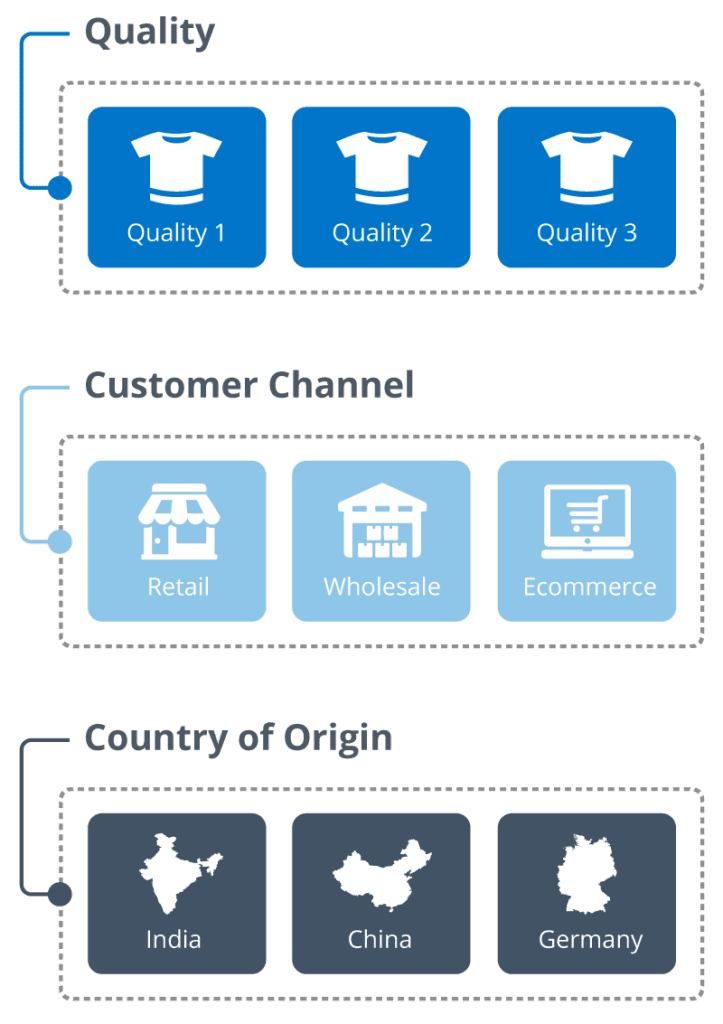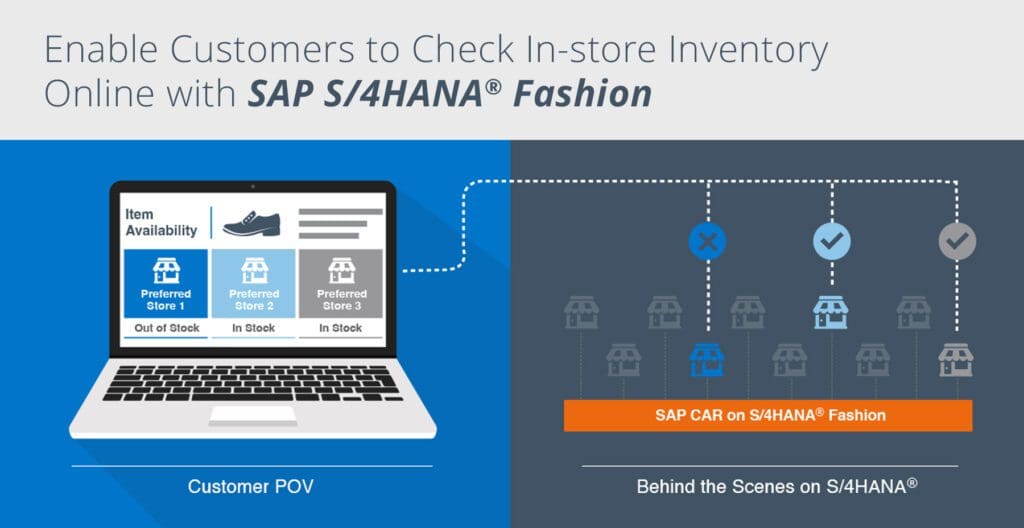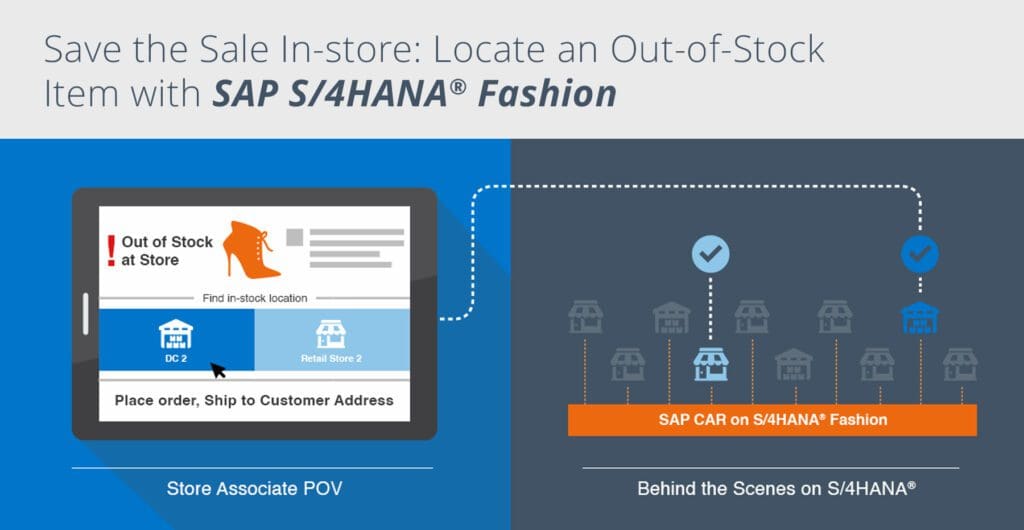Welcome back to our use case series on SAP S/4HANA® Fashion.
This time, we’ll look at Inventory Management with SAP S/4HANA Fashion and how it lets fashion brands manage stocks more profitably with greater visibility into real-time inventory across wholesale and retail.
1. Stock Protection via Product Allocation on Advanced ATP
Fashion companies and vertical businesses often sell through a multitude of channels. However, not all the orders are placed at the same time.
Important customers may place orders late, so it’s important to protect stock for them. S/4HANA Fashion and Vertical Business offers a powerful and integrated stock protection mechanism to ensure that fashion companies don’t lose their most valuable customers.
Stock Protection on SAP S/4HANA for Fashion works by prioritizing demand plans during the sales cycle. Unpredictable problems like increased demand can lead to critical situations in order processing, which ideally should be prevented before they arise.
Fashion companies must prioritize customers, channels, or markets to serve the most important customers first. Stock protection helps companies by protecting inventory for high priority demand even if important sales orders are received late and low priority orders precede them.
For example, a fashion company has retail, e-commerce, and wholesale sales channels. Ecommerce is priority 1, retail as priority 2, and wholesale as priority 3 as below:

If e-commerce does not have sufficient stocks, it can consume 300 units from wholesale and 200 units from retail to ensure demand from profitable channels are always met.
Referred to as Horizontal Stock Protection, this protects channels from cannibalizing each other in order to balancing stock for a profitable outcome.
Fashion retailers can use the same functionality to ensure stock protection for a channel or channel+customer combination, with business rules to ensure other channels can’t consume or poach its stock. This method, referred to as vertical stock protection, protects stock for high priority channels, and is useful if you want to ensure the success of a critical sales channel, even if less important ones are repressed.
2. Demand and Supply Segmentation
 Fashion companies today face intense competition in an increasingly customer-centric global market.
Fashion companies today face intense competition in an increasingly customer-centric global market.
It’s important to streamline internal processes and logistics around the unique requirements of each market through appropriate sourcing, planning, and supply of goods.
To help fashion brands manage demand and supply better, Demand and Supply Segmentation on SAP S/4HANA Fashion categorizes stock logically, based on specific criteria. Using segmentation on SAP S/4HANA for Fashion, you can order materials of different quality levels, for different customer channels, and from different countries of origin. This way, you can easily manage supply with greater visibility into stock, separated by channels.
Some of the key benefits include:
- Easily meet the unique requirements specific to the fashion industry
- Implement rules to segment stock with predefined logical characteristics such as retail or wholesale sales channels or physical characteristics such as quality grade or country of origin.
- Use these characteristics during other processes such as order promising and order allocation
3. Inventory Visibility In-Store: Store As A Fulfillment Center
Store fulfillment is the retailer’s ability to fulfill e-commerce orders in brick-and-mortar store locations.
Services like ship from store and buy online pick up in store are powerful value adds for fashion retailers. Major labels are setting up their stores as fulfillment centers and adopting ship-from-store. They are reaping larger margins on stock sitting idle in stores.
With SAP Customer Activity Repository on SAP S/4HANA Fashion, business rules ensure orders are executed according to the priorities set by the retailer. In the case of click and collect on SAP S/4HANA for Fashion, fashion companies can extend real-time inventory availability to customers.
For instance, customers checking a fashion retailer’s website can determine the store availability online and opt for “click and collect” service by choosing their preferred store.

4. Endless Aisle: Fulfilling Out of Stock Products
Historically, if a customer placed an order for a product not in stock, the order would be cancelled or placed on hold until the item was restocked.
However, when SAP S/4HANA Fashion is connected to your POS and e-commerce system, if an order for an out of stock product is placed, then inventory visibility allows to still fulfill that order from another location where the item is in stock, including inventory held in other channels.
This functionality can be used across all sales channel. In doing so, fashion retailers can maintain adequate in-stock quantities while eliminating duplicate safety stock, which legacy systems held separately in each inventory pool that often resulted in excess safety stock.
For example, a customer in a brick-and-mortar store wishes to purchase a pair of boots but the store doesn’t have her size. Via an in-store kiosk or POS, the sales associate is then able to fulfill the demand with the right size in stock by routing the order to be fulfilled from the warehouse or a nearby store.

Meeting Tomorrow’s Demand with SAP S/4HANA for Fashion
These use cases depict the value of S/4HANA Fashion ERP solution and its possibilities when connected to a fashion company’s extended IT ecosystem – including POS, e-commerce and CRM.

